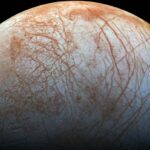Planetary scientists using the Imaging Ultraviolet Spectrograph (IUVS) instrument onboard NASA’s Mars Atmosphere and Volatile EvolutioN (MAVEN) spacecraft have captured two amazing images of the Red Planet. By viewing the planet in ultraviolet wavelengths, they can gain insight into the Martian atmosphere and view surface features in remarkable ways.

This image of Mars was taken with the Imaging Ultraviolet Spectrograph (IUVS) instrument onboard NASA’s MAVEN spacecraft in July 2022. Image credit: NASA / LASP / CU Boulder.
“MAVEN’s IUVS instrument measures wavelengths between 110 and 340 nm, outside the visible spectrum,” members of the MAVEN team said.
“To make these wavelengths visible to the human eye and easier to interpret, the images are rendered with the varying brightness levels of three ultraviolet wavelength ranges represented as red, green, and blue.”
“In this color scheme, atmospheric ozone appears purple, while clouds and hazes appear white or blue.”
“The surface can appear tan or green, depending on how the images have been optimized to increase contrast and show detail.”
The researchers obtained the global views of Mars in 2022 and 2023 when the planet was near opposite ends of its elliptical orbit.
The first image was taken in July 2022 during the southern hemisphere’s summer season, which occurs when Mars passes closet to the Sun.
“The summer season is caused by the tilt of the planet’s rotational axis, similar to seasons on Earth,” they said.
“Argyre Basin, one of Mars’ deepest craters, appears at bottom left filled with atmospheric haze (depicted here as pale pink).”
“The deep canyons of Valles Marineris appear at top left filled with clouds (colored tan in the image).”
“The southern polar ice cap is visible at bottom in white, shrinking from the relative warmth of summer.”
“Southern summer warming and dust storms drive water vapor to very high altitudes, explaining MAVEN’s discovery of enhanced hydrogen loss from Mars at this time of year.”

This image of Mars was taken with the Imaging Ultraviolet Spectrograph (IUVS) instrument onboard NASA’s MAVEN spacecraft in January 2023. Image credit: NASA / LASP / CU Boulder.
The second image is of the Martian northern hemisphere and was taken in January 2023 after Mars had passed the farthest point in its orbit from the Sun.
“The rapidly changing seasons in the north polar region cause an abundance of white clouds,” the scientists said.
“The deep canyons of Valles Marineris can be seen in tan at lower left, along with many craters.”
“Ozone, which appears magenta in this ultraviolet view, has built up during the northern winter’s chilly polar nights.”
“It is then destroyed in northern spring by chemical reactions with water vapor, which is restricted to low altitudes of the atmosphere at this time of year.”



